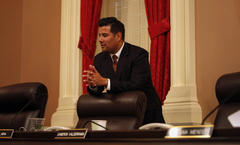Upcoming Feb. 25 Atlantic Information Services virtual conference to present a comprehensive overview of designing and executing private exchanges.
Washington, DC (PRWEB) January 14, 2014
Health insurers now face a radically different marketplace as the shift in employer health benefits to defined contribution has triggered a boom in private exchanges. The new mantra is to keep costs under control and involve consumers in plan purchasing. On Feb. 25, Atlantic Information Services, Inc. (AIS) will host “Making Private Exchanges Work for Insurers,” a virtual conference offering details of how private exchanges work, which models are most successful at gaining members, and the pros and cons for insurers of taking part in nonproprietary exchanges versus building their own. Participants will gain a solid understanding of the current legal, marketing and general business strategies for insurers and their employer clients, with an eye on future developments.
Split into four sessions led by many of the nation’s private exchange experts, including top industry consultants, lawyers working in the health care sector and Wall Street analysts, topics to be covered include the following:· The business model for private exchanges and how insurers expect to prosper by operating their own proprietary exchanges or selling coverage on other marketplaces.
· How defined contribution is playing into employer decision making and the ramifications of shifting health benefits to private exchanges.
· Profiles of current private exchanges: Who is operating them? Who is buying and selling products on them? Which models are attracting the most business? How will the 2014 open-enrollment season play into what comes next?
· Detailed action plans on how to build, market and operate a private exchange, with valuable information on dealing with vendors, constructing a consumer-facing online marketplace, and deciding on an attractive product mix that will be most effective at appealing to insurance buyers.
Additionally, each session will conclude with generous time allocated to answering individual questions.
AIS’s virtual conference allows participants to attend a live conference without having to travel to a meeting site. Plus, the registration fee includes a free On-Demand recording of each session, so any agenda items can be reviewed at a later time.
For more information, including a full agenda, speaker biographies and how to register, visit http://aishealth.com/private-exchanges.
About AIS
Atlantic Information Services, Inc. (AIS) is a publishing and information company that has been serving the health care industry for more than 25 years. It develops highly targeted news, data and strategic information for managers in hospitals, health plans, medical group practices, pharmaceutical companies and other health care organizations. AIS products include print and electronic newsletters, websites, looseleafs, books, strategic reports, databases, webinars and conferences. Learn more at http://AISHealth.com. Reported by PRWeb 13 hours ago.
Washington, DC (PRWEB) January 14, 2014
Health insurers now face a radically different marketplace as the shift in employer health benefits to defined contribution has triggered a boom in private exchanges. The new mantra is to keep costs under control and involve consumers in plan purchasing. On Feb. 25, Atlantic Information Services, Inc. (AIS) will host “Making Private Exchanges Work for Insurers,” a virtual conference offering details of how private exchanges work, which models are most successful at gaining members, and the pros and cons for insurers of taking part in nonproprietary exchanges versus building their own. Participants will gain a solid understanding of the current legal, marketing and general business strategies for insurers and their employer clients, with an eye on future developments.
Split into four sessions led by many of the nation’s private exchange experts, including top industry consultants, lawyers working in the health care sector and Wall Street analysts, topics to be covered include the following:· The business model for private exchanges and how insurers expect to prosper by operating their own proprietary exchanges or selling coverage on other marketplaces.
· How defined contribution is playing into employer decision making and the ramifications of shifting health benefits to private exchanges.
· Profiles of current private exchanges: Who is operating them? Who is buying and selling products on them? Which models are attracting the most business? How will the 2014 open-enrollment season play into what comes next?
· Detailed action plans on how to build, market and operate a private exchange, with valuable information on dealing with vendors, constructing a consumer-facing online marketplace, and deciding on an attractive product mix that will be most effective at appealing to insurance buyers.
Additionally, each session will conclude with generous time allocated to answering individual questions.
AIS’s virtual conference allows participants to attend a live conference without having to travel to a meeting site. Plus, the registration fee includes a free On-Demand recording of each session, so any agenda items can be reviewed at a later time.
For more information, including a full agenda, speaker biographies and how to register, visit http://aishealth.com/private-exchanges.
About AIS
Atlantic Information Services, Inc. (AIS) is a publishing and information company that has been serving the health care industry for more than 25 years. It develops highly targeted news, data and strategic information for managers in hospitals, health plans, medical group practices, pharmaceutical companies and other health care organizations. AIS products include print and electronic newsletters, websites, looseleafs, books, strategic reports, databases, webinars and conferences. Learn more at http://AISHealth.com. Reported by PRWeb 13 hours ago.
 The Department of Health and Human Services released new Obamacare numbers Monday for the federal exchange and the 14 state exchanges, including demographic information for the first time.
The Department of Health and Human Services released new Obamacare numbers Monday for the federal exchange and the 14 state exchanges, including demographic information for the first time. California Lawmaker Proposes Healthcare for Illegal Immigrants
California Lawmaker Proposes Healthcare for Illegal Immigrants With the high-profile introduction and rollout of Obamacare, people have had a lot to say on the topic of health insurance -- including Wanda Sykes. On a recent episode of "Wanda Sykes Presents Herlarious," the comedian started her stand-up routine with a focus on government healthcare, beginning with why it might be a good thing for Chicago Bulls point guard Derrick Rose.
With the high-profile introduction and rollout of Obamacare, people have had a lot to say on the topic of health insurance -- including Wanda Sykes. On a recent episode of "Wanda Sykes Presents Herlarious," the comedian started her stand-up routine with a focus on government healthcare, beginning with why it might be a good thing for Chicago Bulls point guard Derrick Rose. Filed under: Auto Insurance, Health Insurance, Homeowners Insurance, Consumer Issues, Consumer Protection
Filed under: Auto Insurance, Health Insurance, Homeowners Insurance, Consumer Issues, Consumer Protection